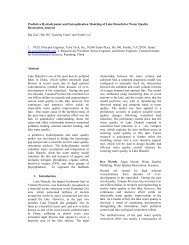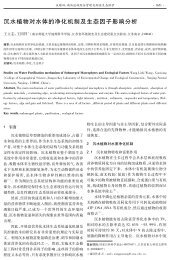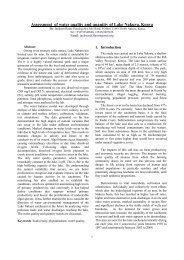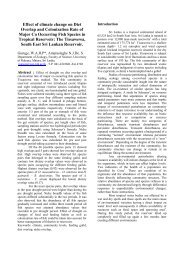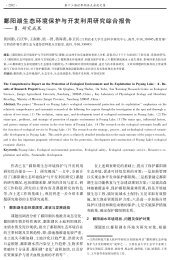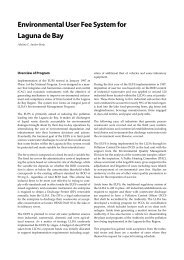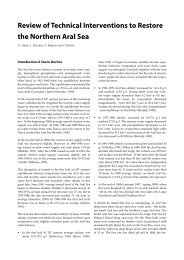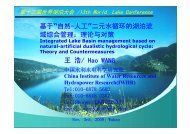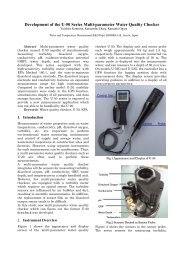Presentation - World Lake Database - ILEC
Presentation - World Lake Database - ILEC
Presentation - World Lake Database - ILEC
Create successful ePaper yourself
Turn your PDF publications into a flip-book with our unique Google optimized e-Paper software.
Economic Valuation in the <strong>Lake</strong> Basin ManagementDecision Making Process : Lessons from Bhoj Wetland,India*MADHU VERMA,Environmental Economist & Professor,Area of Environment and Developmental EconomicsINDIAN INSTITUTE OF FOREST MANAGEMENT,(Undertaking of MOEF, GOI), BHOPAL, M.P., INDIA*(Outcome of An EERC project titled ‘ Economic Valuation of Bhoj Wetlands for Sustainable Use’undertaken during 1999- 2001 Under the EMCaB Technical Assistance Projectof The <strong>World</strong> Bank, Implemented by The MOEF, GOI,. The efforts of the support research teamcomprising of Nishita Bakshi and Ramesh P.K. Nair are duly acknowledged)Pic: Upper lake during Sunset
<strong>Presentation</strong> Structure•Need for the Project•Site Description•Ecosystem Services from Bhoj Wetland (BWL)•Stakeholders Identification•Threats to the Wetland•Interventions by Management Agency•Need for Understanding Economic Values of theWetland• Need for Prioritisation of Interventions•Lack of Payment Mechanism for Maintenance•Understanding BWL Ecosystem throughEcosystem Modelling•Economic Valuation Across DifferentStakeholders•Recommendations -Technical and PolicyInstitution based Interventions•Lessons LearntPic: View of Bhoj Wetland fromShymala HillsPic: View of Bhoj Wetland fromIIFM campus
WETLANDS“Areas of marsh,fen, peatland orwater whether natural or artificial,permanent or temporary,with waterthat is static or flowing, fresh,brackish or salt, including areas ofmarine water, depth of which at lowtide does not exceed six meters” andmay include “riparian and coastalzones adjacent to the wetlands orislands or bodies of marine waterdeeper than six meters at low tidelying within (IUCN 1971)Pic: Panaromic View of Upper lake from Shyamala Hills
BHOJ WETLANDS (BWL)*ONE OF THE 16 WETLANDS OF NATIONALIMPORTANCE UNDER NLCP(1986)* RAMSAR SITE SINCE DECEMBER 2002* FRESH WATER LAKE COMPRISES OF UPPER ANDLOWER LAKEUPPER LAKE* EARTHEN DAM WAS BUILT ACROSS RIVER KOLANSIN 11TH CENTURY BY RAJA BHOJ* CATCHMENT AREA OF 361 Sq. km* WATERSPREAD AREA OF 31 Sq. kmPic: Yatch Club in the Upper lake in 1961LOWER LAKE*CREATED IN 18TH CENTURY* CATCHMENT AREA OF 9.6 Sq. km* WATERSPREAD AREA OF 1.29 Sq. km* FED BY SEEPAGE FROM UPPER LAKE AS WELL ASSEWAGE FROM 8 DRAINSPic: Portrait of Yatch Club
Maps of the Bhopal City (habitation area in blue, partial boundary of lake shown in blackin the west of the city) since the formation of the Upper <strong>Lake</strong> one thousand years back1010 - 1200 AD 1201-1800 AD 1801-1850 AD 1891-1930 AD1931-1950 AD 1950-1972 AD1973-1981 AD 1981-1991 ADSource:www. Bhopalinfo.com
Source :<strong>Lake</strong> Conservation Authority (LCA), Bhopal
ECOSYSTEM SERVICESPROVIDED BY THE BHOJWETLANDA.CONSUMPTIVE(Substractible)•DRINKING WATER•FISH, CHESTNUT PRODUCTION•MICROCLIMATIC STABILISATION•NUTRIENT CYCLINGB. NON CONSUMPTIVE(Non Substractible)•RECREATION•BIODIVERSITY•AESTHETIC•EDUCATIONPic: Island in the middle of the lakePic: Boating activity in the upper lake.
STAKEHOLDERS OF THE BWLA. PRIMARY•Enttre population of Bhopal city• Municipal wards around the lake•Farmers in the catchment•<strong>Lake</strong> front property owners•Washermen•Fisherman•Water chestnut cultivators•Vendors•Visitors`B. SECONDARY•Water Supplying Agencies•Bhopal Muncipal Corporation (BMC)•Department of Housing & Environment (DOHE)•Sports Authority of India (SAI)•Van Vihar National Park (VVNP)• Madhya Pradesh Tourism Development Coeporation (MPTDC)• Ministry of Environment & Forest (MOEF), Govt. of India•Photographers, Film makers. Bird watchers, Students population, Researchers.PIC : DUCKS NEAR THE BOAT CLUBC. TERTIARY•Funding Agencies like the <strong>World</strong> Bank, JBIC & State Govt.•International Agencies of Wetland Conservation like Ramsar Bureau , IUCN•Organisations in India like CSO, MOSPI, CSE, TERI• Inter National Organisations IIED, WII, WWF, RFF, CSERGE, <strong>ILEC</strong>, JBIC, JICA,WI, Various Universities• International Societies on Ecological Economics & Ecosystem Health
THREATS TO THE WETLAND☯ SILTATION☯ SOLID WASTE POLLUTANTS☯ SEWERAGE☯ WASHING ACTIVITIES☯ TRAPA CULTIVATION☯ ENCROACHMENT☯ INCREASING POPULATION☯ WEEDS & EUTROPHICATION☯ BOATING☯ AGRICULTURAL RUNOFF☯ IDOL AND TADJIAIMMERSION☯HOSPITAL WASTEPic: Flow of sewage & siltation from adjoining colonies.Pic: Bathing at the idol immersion bank.
MAJOR INLETS OF POLLUTIONLAKEPOLLUTION AND SILT TO THE UPPERSILT &SEWAGEINFLOWREDUCTION INCAPACITY &PROLIFERATION OFWEEDSDETERIORATION OFWATER QUALITYUPPERLAKELLLower lake is thesource of raw water•VERY HIGH DENSITYABOVE 400 PERSONS/HA•HIGH DENSITY250-400 PERSONS/HA•MEDIUM DENSITY125-250 PERSONS/HA•LOW DENSITY25-125 PERSONS/HA•VERY LOW DENSITYUPTO 25 PERSONS/HA•RURAL AREASEWAGE INFLOWSILT INFLOW
Implementation of Bhoj Wetland Project by Govt of Madhya Pradesh, India withJBIC Support (1 st April 1995 to 12 th June 2004)Project Outlay : Rs. 247.03 CroresActivities Proposed to be Undertaken by the year 2000•DESILTING AND DREDGING WORKS•Desilting and dredging of lakes•Deepening and widening of the spill channel•Restoration of the takia island•CATCHMENT AREA TREATMENT•Afforestation, creation of buffer zones•Construction of check dams, silt traps, toe walls•Construction of garland drains around lower lake•SHORELINE AND FRINGE AREA MANAGEMENT•Retghat Lalghati Road (Buffer Zone)•Solid Waste Management•Prevention of Pollution From Dhobi Ghats•WATER QUALITY MANAGEMENT•Deweeding•Monitoring of water quality•Installation of floating fountains, ozonisers•AquacultureSequence of ActivitiesTill 1999 mostly defensive interventions like installation of floating fountains, ozonisers were takenup first instead of addressing the main problem of flow of sewage to the lake, hence the net effectof other interventions seem to be either nil or negative. Above various stockholders/ beneficiarieswere not involved in the planning and implementation process.Future Planning and Payment MechanismBy 2000, no future planning regarding maintenance of various engineering structures was done bythe BWL agency after the project is over and no mechanism was evolved for generation ofpayments from the beneficiaries to pay back the loan amount from JBIC amounting to Rs. 220
Keeping in mind the status of theJBIC supported BWL project, thestudy attempted to :• Analyze factors causing BWL degradation• Estimate nature and extent of injury to thewetland•Quantify impact of degradation on benefits•Find out cost borne by the stakeholdersPic: View of the Takia Island in Upper lake• Use feedback from various impacts torevise management policies•Envisage participation of stakeholders•Generate values of various uses•Know the WTP of people to conserve theBWL•Provide feedback to management agencyfor appropriate interventionsPic: The Upper <strong>Lake</strong> in the back drop of old Bhopal City.
Major objectives of theEconomic Valuation Project1. To value fully wetlandbenefits/resources forappropriate allocation ofwetland uses and funds2. To help planners and policymakers to develop a sociallyacceptable, environmentallysound and financially feasiblestrategy for wetland management.Pic: Magnificent upper lake in the evening
METHODOLOGY♦Literature Review♦ Site Visits♦ Stakeholders Consultations♦ Focused Group Discussions♦ Secondary Data Collection♦Stakeholders Workshops (Allprimary and secondarystakeholders plus theCorporators)Pic: Water chestnut cultivation in the upper lake.♦Expert Consultations♦Round table Discussions♦ Ecosystem’s Modelling♦Primary Data Survey♦Data Analysis♦ RecommendationsPic: Growth of water hyacinth in the upper lake.
ECOSYSTEM MODEL FOR BHOJ WETLAND(Based on water quality parameters from eight representative monitoringstations)A. MODEL VARIABLES* Turbidity*Ph*Total Dissolved Solids*Phosphate*Hardness*Dissolved Oxygen*Biochemical Oxygen Demand*Bacteria (Mpn)*Weed Area*Population*SewagePic: View from IIFM campusB. INTER LINKAGES OF MODEL VARIABLES and MODEL DEVELOPMENT- Estimation of ElasticityCoefficients, Setting up Model Using Coefficients, Absolute values of variables and Settingup of Base Model using STELLA Software (Systems Dynamics Model)C. ASSESSMENT OF IMPACT OF ONGOING RESTORATION ACTIVITIES THROUGH SIMULATIONPic: View of Widened canal from IIFMRUNS
ZONES AND SAMPLING POINTS OF THE UPPER LAKE0511503060402 07A B C14110810 091312S1 – Kolans (Upper <strong>Lake</strong>)S2 - Bairagarh (Upper <strong>Lake</strong>)S3 - Kamla Park (Upper <strong>Lake</strong>)S4 – Spill Channel (Upper <strong>Lake</strong>)S5 – Deeper Zone (Upper <strong>Lake</strong>)S6 – Boat House (Lower <strong>Lake</strong>)S7 – Deeper Zone (Lower <strong>Lake</strong>)
Table 1: Compound Growth Rates of Selected Parameters in 1991 using1985 as base year ( for theUpper <strong>Lake</strong>)Sl.No. Variable Units CGR Base Year (1985) Final year 19911 Population Number 0.0338 109187 1332872 Sewage MillionLiter /Day0.0101 31.3927 33.3443 Weeds Km2 0.3046 0.7 5.875 (1993)4 BOD Mg/l 0.0417 2.5545 3.285 Bacteria Counts/100ml0.1098 358 6706 PH 0.0051 8.7 9.07 TotalDissolvedsolidsMg/l 0.0608 86 122.558 TotalMg/l 0.0351 88 108.24Hardness9 D.O Mg/l 0.0324 4.0 4.8410 Phosphate Mg/l 0.5838 0.01 0.157811 Turbidity NTU -0.0188 4.0 3.57
Table 2: Compound Growth Rates of Selected Parameters in 1999 using1993 as base year ( for the Upper <strong>Lake</strong>)Variables Units CGR 1993 1999(Average)1. Turbidity NTU 0. 2704 9.5 39.932. p H -0.0109 9.0 8.4263. TDS mg/l -0.0009 128 127.3024. Phosphate mg/l -0.0053 0.4 0.38745. Hardness mg/l 0.0075 86 89.9686. D.O mg/l 0.0280 7.6 8.9687. BOD mg/l 0.1933 2.1 6.0668. Bacteria counts/100ml0.1604 2400 58589. Weed area Km2 0.3046 5.875 0.7 (1985)#10. Population 0.0338 142471 185931*11. Sewage MillionLiters/ Day0.0458 44.92 58.77* Projected for 2001 (From Detailed project report of Solid Waste Management subproject, BMC)# No Data for 1999
Table 3 : Elasticity Matrices of Ecological Parameters of Pre-Restoration stage (Upper <strong>Lake</strong>)Sl.No.PopulationSewageWeedareaB .O. DBacterialCountpHDissolvedHardness D. O Phosphate TurbiditySolidsCGR 0.0603 0.0101 0.3046 0.0417 0.1098 0.0051 0.0608 0.0351 0.0324 0.5838 -0.0188Population1.000 0.1675 5.0514 0.6915 1.8209 0.0846 0.3051 0.5821 0.5373 9.6816 -0.3118Sewage5.9703 1.000 30.1584 4.1287 10.8713 0.5049 1.8218 3.4752 3.2079 57.8019 -1.8614Weedarea0.1979 0.0322 1.000 0.1369 0.3605 0.0167 0.0604 0.1152 0.1064 1.9166 -0.0617B .O. D1.4460 0.2422 7.3046 1.000 2.6331 0.1223 0.4412 0.8417 0.7770 14.000 -0.4508BacterialCount0.5492 0.0919 2.7741 0.3798 1.000 0.0464 0.1676 0.3197 0.2591 5.3169 -0.1712PH11.8235 1.9803 59.7255 8.1765 21,5294 1.000 3.6078 6.8824 6.3529 114.4706 -3.6863Dissolved3.2772 0.5489 16.5543 2.2663 5.9674 0.2772 1.000 1.9076 0.5329 9.6020 -0.3092SolidsHardness1.7179 0.2877 8.6781 1.1880 3.1282 0.1453 0.5242 1.000 0.9231 16.6325 -0.5356D. O1.8611 0.3117 9.4012 1.2870 3.3889 0.1574 1.8765 1.0833 1.000 18.0185 -0.5802Phosphate0.1033 0.0173 0.5218 0.0714 0.1881 0.0087 0.1041 0.0601 0.0555 1.000 -0.0322Turbidity-3.2074 -0.5372-16.2021 -2.2181 -5.8404 -0.2713 -3.2340 -1.8670 -1.7234 -31.0532 1.000
Figure 1: Ecosystem Model for Bhoj Wetland Using Water QualitypopulationdpopdtsewageAlkalinitydsewdtPhosphateweedsdAlkalinitydtdpodtBODdweedsdtpHPhytoplanktondBODdtdpHdtdphytodtTotal Dissolved SolidsTotal hardnessdtsdtdthdtBacteriaTurbiditydbactdtDissolved Oxygendt turbdtdDOdt
1:2:3:4:5:1: sewage 2: Totaldis solved … 3: Total hardnes s 4: Turbidity 5: weeds75.001500.001500.00100.0032.001:2:3:4:5:53.20793.00794.0052.0016.3551:2:3:4:5:2331.39186.001 388.0054.001 320.70 1 3 4 4 4 40.00 6.25 12.50 18.75 25.00Graph 2 (Untitled)Years6:32 PM Tue, Nov 07, 2000Graph Showing Changes in Various Limnological Parameters in Pre Restoration Conditionsof Bhoj Wetland – Upper <strong>Lake</strong>
1:2:3:4:5:1: Bacteria 2: BOD 3: Diss olved Oxy… 4: pH 5: Phos phate16000.001000.0050.0014.004.001:2:3:4:5:10929.00501.0528.8010.422.0031:2:3:4:5:42 35858.0042.107.6015 3 5 4 5 56.84320.00 240.00 6.25 12.50 18.75 25.00Graph 1 (Untitled)Years4:57 PM Fri, Nov 10, 2000Graph showing Changes in Various Limnological Parameters of OngoingRestoration Activities In Upper <strong>Lake</strong> (Cont.)
1:2:3:4:5:1: population 2: sewage 3 : To tal Di ssol ve d… 4: Total hardnes s 5: Turbidity500000.0075.00150.00200.00100.001:2:3:4:5:1:2:3:4:5:321235.5059.96137.50125.0054.75254 414 3 43142471.00344.92 2 31125.0050.009.50 10.00 6.25 12.50 18.75 25.001Graph 2 (Untitled)Years4:57 PM Fri, Nov 10, 2000Graph showing Changes in Various Limnological Parameters of OngoingRestoration Activities In Upper <strong>Lake</strong>
VALUATION METHODOLOGIESUSED1. DIRECT VALUATION THROIGHMARKET PRICE APPROACH2. COST OF ILLNESS & PREVENTIVECOST APPROACH3. CONTINGENT VALUATION METHOD4. HEDONIC PRICINGPic: Upperlake against beautiful sunset.
RESULTS OF VALUATIONEXERCISEVALUE OF THE DRINKING WATERSUPPLYPic: Kamla Park located pumping station.Rs 9,54,13,962 or US$ 2,120,310(assuming US$ 1 = Rs 45/-)MPTDC REVENUERs 387330 or US$ 8607INCOME TO FISHERMENRs 80,00,000 or US$ 177,778INCOME TO BOATMENRs 24,37,880 or US$ 54,175INCOME TO TRAPA CULTIVATORSRs 50,000 or US$ 1111Pic: Fishing Activities in Lower lake
INCOME TO WASHERMENRs 36,00,000 or US$ 80,000INCOME TO ROADSIDE VENDORSRs 14,16,000 or US$ 31,467COST OF ILLNESS APPROACHRs 12,00,254 or US$ 26,672TOTAL HOUSEHOLD COST OFWATER PURIFICATIONRs 1,24,35,876 or US$ 276,353WTP OF THE PEOPLE AS AVOLUNTARY CONTRIBUTIONANNUALLYRs 4,84,68,956/- or US$1,077,088WTP OF THE PEOPLE AS TAXANNUALLYRs 59,32,922/- or US$ 131,843Pic: Washing Activity at Lower <strong>Lake</strong>.
Pic: View of the Upper lake & old Bhopal City fromthe Arches.DESCRIPTION OF MAINVALUATION METHODSI.CONTINGENT VALUATIONA. Questionnaire*Attitudinal Question*Scenario Building* Valuation*Payment Vehicle# Voluntary Payment to BWL MaintenanceSociety#Compulsory Tax To Govt.B. Sample Size* 1500 Households out of Total No. of2,01,116 (0.74 %)Households constituting1.5 Million Population of Bhopal City•Samples from all 66 wards in proportion totheir share in total population
Extrapolated Willingness To pay (WTP ) for Entire cityMedian FINVOLper household perannum = Rs241.00/-(US$ 5.35)Median FINTAXper household perannum = Rs29.50/-(US$ 0.65)Total Number ofhouseholds inCity = 2,01,116Total VoluntaryWTP per annum =Rs 4,84,68,956/-(US$ 1,077,087)Total WTP as taxper annum = Rs59,32,922/-(US$ 181,842)WTP in Rs800700600500400300200100035030025020015010050Income in Rs0Private Sect or Government Self Ot herVoluntary TaxOccupation
II. HEDONIC PRICINGRanking Of Various FactorsConsidered While Buying PropertyS. No: Factor Scores1. Drinking Water 0.992. Safety 0.943. School0.88Quality of 0.87Construction 0.87Hospital6. Age of House 0.857. ParkMarketAir Pollution0.800.790.7910. Work Place 0.7711. DensityNoise Pollution0.700.7013. <strong>Lake</strong> 0.6714. Household Help 0.5615. Road 0.31Estimation Results Of Hedonic PricingDependent Variable = Price in Rs/sq.ft Number of Observations = 27R squared = 0.781 Package Used = SPSS 10.0Variable Coefficient t - statisticCONSTANT -607.596 -3.883NEIGHBOURHOOD 282.739 4.591MARKET -112.570 -1.661ACCESS 101.902 1.575LAKE 185.896 2.518ENVIRONMENT 111.047 2.097HOUSING DENSITY -67.203 -1.379Estimating partial correlation coefficient, 50% pricedifferential was found in the lake front properties onaccount of amenity values of lake.
TECHNICALRECOMMENDATIONS•Preventive measures before implementationof the corrective measures mainly sewageand silt flow to the lake in the urbancatchment and agriculture nutrient s to thelake from the rural catchment• Develop view points around the lakes• Promote EcotourismPOLICY / INSTITUTIONALPic: Current State of BWL at most of the points* seek people’s participation* Generate effective co-ordination betweenall line departments* Evolve transparent system of management* Set up Bhoj wetland maintenance society* Set up system to collect payments /voluntary contributions from people toimprove recreational facilities* Set up management fund for maintenanceof lakePic: Sunset view at Khanugaon area of BWLCould Always be the Future State of Entire BWL
POLICY / INSTITUTIONALRECOMMENDATIONS…..* Use valuation exercise as basis for futuremanagement strategies* Carry out detailed cost benefit exercise* Prioritise restoration activities usingPic: Takia Island as viewed from the Hilltopsimulation runs of comprehensive ecologicalmodel* Conduct detailed study of rural catchmentPic: Water Tourism in the <strong>Lake</strong>
Bhoj Wetland Maintenance Society asProposed under the IIFM ProjectSTRUCTURERepresentatives from Line Departments, Primary Stakeholders,Citizens, Research Institutions, NGOs, MediaFUNCTIONS AND ACTIVITIES• Maintain Water Quality And Improve <strong>Lake</strong> Management• Build Parks And Maintain Them• Better Boating Facilities With Introduction Of Water AndAdventure Sports• Encourage Sport Fishing Using RodsPic: View from Shymala Hills• Hold Summer Camps Fro Children And Youth For Water RelatedRecreational Activities• Promote Eco-tourism By Encouraging Visitors To Learn About<strong>Lake</strong>’s Ecosystem And Biodiversity• Awareness To Decrease Water Pollution By Regulating Use OfPolythenes Etc And Water Consumption•Develop View Points With Sitting And Refreshment Arrangements• Introduction Of Dal <strong>Lake</strong> Kashmir Like House Boats• Generate Awareness For Clean <strong>Lake</strong>s By Holding Annual <strong>Lake</strong>Festival, Distributing Souvenirs,•Creating Consciousness To Save the Pride and Heritage of BhopalCityPic: Sunset view
Use of Project Findings Through Ecosystem Model andEconomic Valuation Exercise in <strong>Lake</strong> Basin ManagementDecision Making Process Since 2000A.By the BWL Agency now called as the <strong>Lake</strong> Conservation Authority (LCA)set up in 2004The author submitted the report in multiple copies to the BWL agency in2001, but was not called up for the presentation after two years ofsubmission thoughThankshe made many presentationsyouin various cities of Indiaand was invited for presentations to many agencies abroad.Few recommendations have so far been considered by the BWL Agency like• Increased public participation, intensification of preventive measures likesewage and silt control• Interventions in the rural catchment by awareness building and capacitybuilding for Organic cultivation• Awareness building in the urban catchment through display of information
But• Detailed Cost Benefit Analysis of individual subprojectsis yet to be done.• No mechanism of generation of finance formaintenance has been developed by the LCA .Thus the already burdened taxpayer of thestate shall have to pay for the loan provided byJBIC• The Payment Mechanism suggested through CVMexercise of IIFM project from the beneficiariesis yet to be ImplementedThus• Despite availability of various useful suggestionsthe report has been partially used by the LocalManagement AgenciesPic: Panoramic View of Upper lakefrom Shyamla Hills• Despite data availability for water quality, theagency did not take up intensive EcosystemModelling for various monitoring stations so asto make specific interventions
B. By Various National and International Organizations and WetlandSitesIn IndiaStudy has been adopted as a Model Study for Valuation, Cost Benefit Analysisand Development of Management Plan for <strong>Lake</strong>s of Hyderabad and referredfor lakes of Bangalore in Karnataka, Nainital lake in Uttarakhand, Dal lakeinJammu & Kashmir, Loktak lake in Manipur etc.By International Agencies• Ramsar website hosts a Photo gallery and project Findings since 2001• IUCN has put up an Executive Summary on its Website since 2001• The author has presented the study findings at the conference of theInternational Society for Ecosystem’s Health in Australia; conference of theInternational Society for Common Property in Mexico; at the Resources forthe Future in Washington D.C. in USA.• Ramsar Convention has provided with in Australia travel support to presentEcosystem Model in Brisbane.• International Institute for Environment and Development (IIED), UK andWinrock International, India (WII) considered the study to select the BWL siteas one of the two sites in India as a component of six country study forintroducing incentive based mechanisms for livelihoods protection servicesin the rural catchment and the authour did the livelihoods baseline andimpact studies under the project.Pic: View from theTop point of the city
Currently, <strong>ILEC</strong> has considered the study as a case fordisseminating the use of Economic Valuation Techniques for<strong>Lake</strong> Basin Management process under JICA projectThank youTHANK YOUPic. Portrait of the then Yacht Club in the <strong>Lake</strong>Sources of pictures : Dr. Madhu Verma & Research Team, IIFM Bhopal; Central ColorLab, Bhopal, & Individual collection from Mr. Prem Verma, Bhopal.



